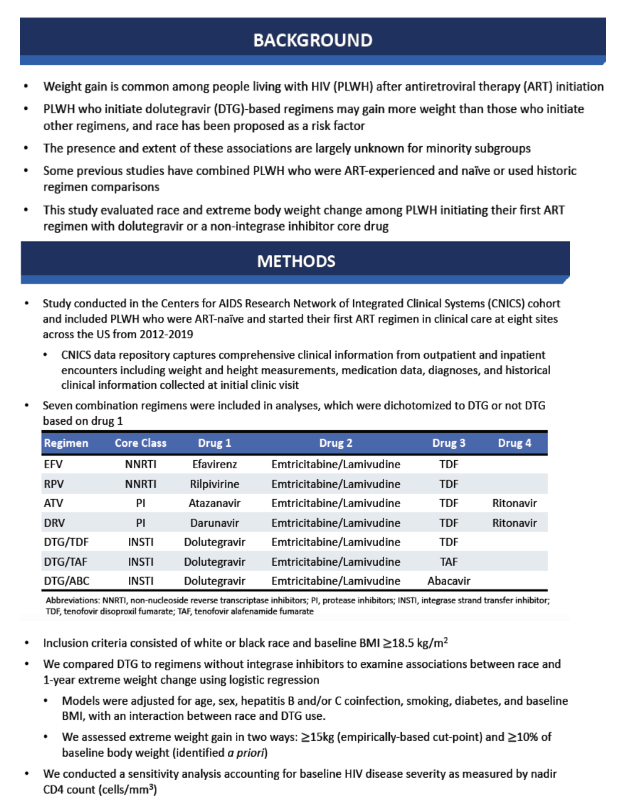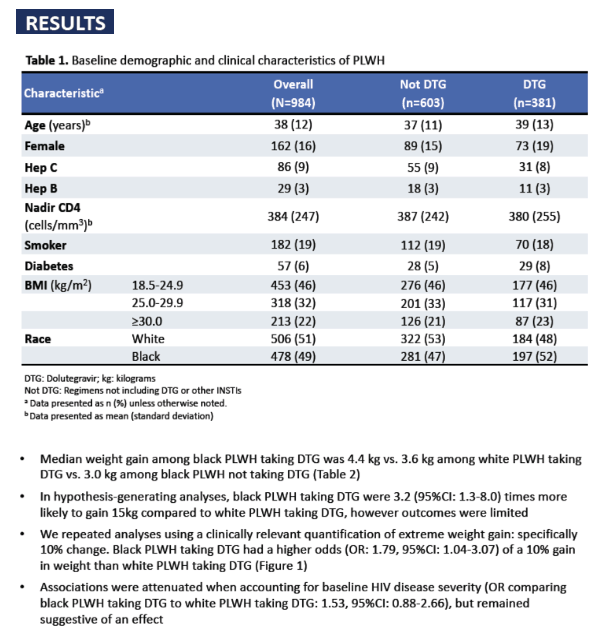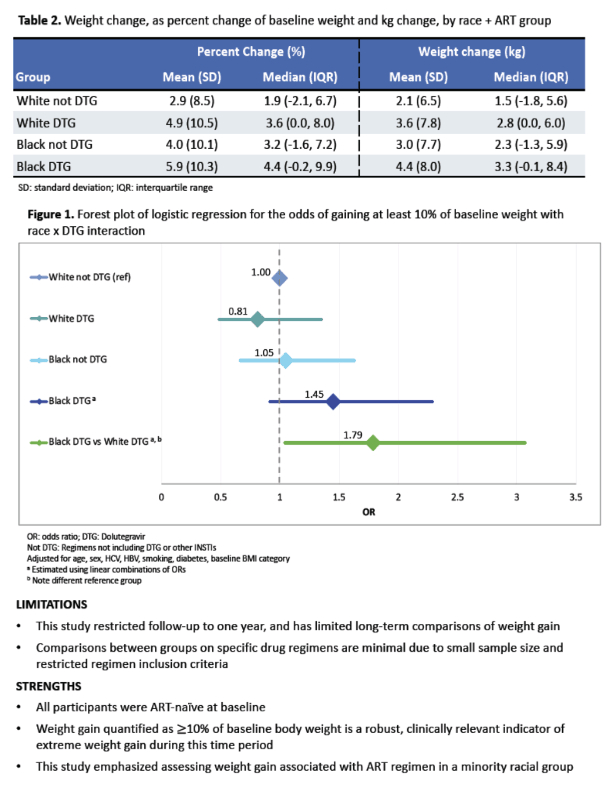 |
 |
 |
| |
Race Impact on Dolutegravir-Associated Weight Gain Among
Previously ART-Naïve People Living with HIV
|
| |
| |
CROI 2020
Reported by Jules Levin
SA Ruderman1, RM Nance1, BM Whitney1, KH Mayer2, RD Moore3, JJ Eron4, WC Mathews5, MS Saag6, GA Burkholder6, MM Kitahata1, S Lindstrom1, BR Wood1,
AC Collier1, JAC Delaney7, HM Crane1
1University of Washington, Seattle, WA, USA; 2Harvard Medical School, Fenway Institute, Boston, MA, USA; 3Johns Hopkins, Baltimore, MD, USA; 4University of North Carolina, Chapel Hill, NC, USA; 5University of California San Diego, San Diego, CA, USA; 6University of Alabama at Birmingham, Birmingham, AL, USA, 7University of Manitoba, Winnipeg, Manitoba, CA

---------------------------
Sax et al. Is modern antiretroviral therapy causing weight gain?....http://www.natap.org/2019/EACS/EACS_37.htm
"....Collectively our results suggest that there are demographic-, HIV- and treatment-related contributors to weight gain in PWH. Our findings raise the possibility that modern ART regimens with improved tolerability and potency may lead to weight gain in some PWH, necessitating increased clinical attention to the maintenance of healthy body weight, lifestyle modification, and exercise at ART initiation.39-40 Ongoing studies including the analysis of weight gain in ART switch trials may provide important insights by avoiding the contribution of return-to-health effects. Additional important areas for investigation include the magnitude, clinical significance, and biologic mechanisms of ART-related weight gain.
We did not observe a clinically significant metabolic impact of weight gain in our trials as measured by fasting glucose and investigator reported AEs, however this analysis is limited by duration of follow-up, a relatively small number of reported AEs, and the absence of more sensitive markers of glucose tolerance.
In our pooled analysis of eight ART-naïve randomized clinical trials ranging from 2003 to 2019, we found that PWH are initiating ART at higher baseline weight and many gain significant amounts of weight during the first two years of therapy. A mix of demographic, HIV disease-specific, and ART-specific factors were associated with weight increase from baseline and with more extreme (≥10%) weight gain.
Black race and female sex were associated with weight gain, consistent with other studies.2,5-6,13,15 This association was particularly notable among black females, who gained approximately twice as much weight as non-black women.
In our pooled analyses, INSTI-containing regimens were associated with more weight gain than NNRTI or PI-based regimens, with DTG and BIC associated with more weight gain than EVG/c. Among NNRTIs, RPV was associated with more weight gain than EFV. Among NRTI pairs, TAF/emtricitabine (FTC) was associated with the most weight gain, ABC/lamivudine (3TC) and TDF/FTC with slightly less weight gain, and AZT/3TC with weight stability. These findings are similar to the ADVANCE trial, in which DTG and TAF were associated with treatment-emergent obesity, while TDF/FTC/EFV was associated with treatment-emergent underweight status and a higher rate of treatment discontinuation.25 Altogether, these findings establish a pattern of more weight gain with newer ART regimens, possibly reflecting better tolerated, easier to take regimens.26
The hypothesis that improved tolerability may contribute to weight gain in PWH initiating ART is supported by clinical trial data comparing the gastrointestinal (GI) tolerability of HIV regimens. INSTIs such as DTG, BIC, and RAL do not require boosting with cobicistat, which has been associated with nausea and diarrhea.27 Among NNRTIs, RPV is better tolerated than EFV, and should be taken with food which may result in higher caloric intake.28 In the case of NRTIs, early trials demonstrated more GI toxicity with AZT compared to newer NRTIs, including ABC and TDF.29 There is also evidence that TAF may be associated with better GI tolerability than ABC; in a study comparing BIC/FTC/TAF vs. ABC/DTG/3TC, there was a lower incidence of nausea in the TAF-containing arm, a difference not observed in a study comparing BIC with DTG, both with TAF/FTC.30-31
If individual agents contribute to weight gain aside from tolerability, the mechanisms by which they do so is not known. For treatment-naïve PWH, some of the association between weight gain and INSTI-containing regimens could be their faster virologic control compared to older regimens.32 Another explanation for drug-specific effects on weight could be off-target biological interactions. One such example is the observed interaction between DTG and melanocortin 4 receptor (MC4R), a receptor involved in the regulation of caloric intake by modulating leptin signaling in the central nervous system.33-34 This finding is intriguing since mutations in MC4R are associated with heritable obesity.34 This potential mechanism requires further validation, and it remains unknown whether other INSTIs interact similarly.
Evaluating the effect of ART drugs on weight gain is confounded by HIV disease factors such as return-to-health; some of these limitations may be avoided by studying weight changes in pre-exposure prophylaxis (PrEP) trials. In the iPrEx study comparing TDF/FTC to placebo, the TDF/FTC arm gained less weight than placebo, suggesting TDF/FTC may have a mild weight suppressive effect.35 In the DISCOVER trial of TDF/FTC vs. TAF/FTC for PrEP, weight gain at week 48 was 1.1 kg in the TAF/FTC arm with no change in the TDF/FTC arm.36 Finally, in a phase 2 placebo controlled trial of cabotegravir for PrEP, both arms experienced about 1kg of weight gain over 41 weeks, with no significant difference between arms.37 Together these findings suggest that heathy participants taking TAF or an INSTI likely experience weight gain much like the general population, which contrasts with the weight-suppressive effect of TDF.
Weight gain in participants initiating ART
In pooled analyses, the 96-week median weight gain was 2.0 kg (IQR -1.0, 5.8), with the greatest rate of weight gain occurring during the initial 48 weeks (Figure 1C). Through 96 weeks, 48.6%, 36.6% and 17.3% of participants had at least 3%, 5%, and 10% weight increase from baseline, respectively. Weight gain was not observed in all participants; 30.2% lost weight. The proportion of participants in overweight and obese BMI categories increased over time
Risk factors for ≥10% weight increase in participants initiating ART
To understand factors associated with more extreme weight gain, we stratified the pooled trial data into individuals who gained ≥10% body weight over 48 weeks (12.8% of participants) versus those who did not. Individuals with ≥10% weight gain were more likely to be female or black, have a lower baseline weight or BMI, have lower baseline CD4 count, and higher baseline HIV-1 RNA (Table 4).
We assessed the association between the specific third agent drug and ≥10% weight gain (Table 5). Compared to EFV, the initiation of BIC or DTG (OR 1.82, 95% CI 1.24-2.66, p=0.002), EVG/c (OR 1.36, 95% CI 1.04-1.78, p=0.026), RPV (OR 1.51, 95% CI 1.03-2.20, p=0.035), but not ATV/r, were associated with an increased risk of ≥10% weight gain.
Among the NRTIs, TAF (OR 1.75, 95% CI 1.04-2.95, p=0.034), but not ABC or TDF, were associated with increased risk for ≥10% weight gain compared to AZT. TAF was also associated with an increased risk of ≥10% weight gain compared to ABC (OR 1.90, 95% CI 1.25-2.88, p = 0.003) and TDF (OR 1.47, 95% CI 1.14-1.90, p = 0.003).
Metabolic impacts of significant weight increase
Next, we evaluated whether ≥10% weight gain was associated with subsequent changes in fasting glucose or the incidence of treatment-emergent AEs related to diabetes or hyperglycemia. We found no significant difference in fasting glucose change between participants with ≥10% or <10% weight gain (96-week mean fasting glucose change for both groups was 3 mg/dL, 95% CI 1.01-4.99 mg/dL and 2.39-3.61 mg/dL respectively, Supplementary Figure 2A). The incidence rate of diabetes-/hyperglycemia-related AEs was higher in individuals with ≥10% weight gain versus those without, although this difference was not statistically significant (1.01 per 100 person-years [PY] [95% CI 0.59, 1.74] and 0.67 per 100 PY [95% CI 0.53, 0.85] respectively, p = 0.18). LDL and triglycerides had similar small increases in both groups, whereas HDL had a small but significant increase in participants with <10% weight increase compared to those with ≥10% weight increase (Supplementary Figure 2B-D). Total cholesterol-to-HDL ratio was slightly higher in the ≥10% weight gain group (week 96 median [IQR] 3.7 [2.9, 4.6] vs 3.5 [2.9, 4.4] p = 0.027). Blood pressure data are available for three trials (264-0110, 380-1489, and 380-1490); no clinically significant changes were observed (week 96 weighted mean change from baseline in systolic and diastolic blood pressure are 2.2 and 1.5 mmHg respectively).
Similar to other reports, we observed higher baseline weight in more recent ART-naïve studies, with median baseline BMIs at or near the overweight category.1-4 Weight gain was common following ART initiation: about half of participants gained at least 3% body weight with a median weight gain of 2.0 kg over nearly 2 years of follow-up. This degree of weight gain mirrors the obesity trend observed in the NHANES CARDIA study, where the average American aged 20-40 gained nearly one kilogram per year.19 Accordingly, the distribution of BMI classes in trial participants shifted toward overweight and obese categories by trial conclusion, approaching the distribution seen in recent HIV cohort studies and in the general population (approximately 1/3 overweight, 1/3 obese).4,5,19-21"
--------------------------
Race Impact on Dolutegravir-Associated Weight Gain Among
Previously ART-Naïve People Living with HIV
CROI 2020
Reported by Jules Levin
SA Ruderman1, RM Nance1, BM Whitney1, KH Mayer2, RD Moore3, JJ Eron4, WC Mathews5, MS Saag6, GA Burkholder6, MM Kitahata1, S Lindstrom1, BR Wood1, AC Collier1, JAC Delaney7, HM Crane1
1University of Washington, Seattle, WA, USA; 2Harvard Medical School, Fenway Institute, Boston, MA, USA; 3Johns Hopkins, Baltimore, MD, USA; 4University of North Carolina, Chapel Hill, NC, USA; 5University of California San Diego, San Diego, CA, USA; 6University of Alabama at Birmingham, Birmingham, AL, USA, 7University of Manitoba, Winnipeg, Manitoba, CA



|
| |
|
 |
 |
|
|